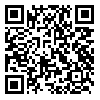BibTeX | RIS | EndNote | Medlars | ProCite | Reference Manager | RefWorks
Send citation to:
URL: http://jdm.tums.ac.ir/article-1-94-en.html
Background and Aims: Nowadays reconstruction of alveolar defects has become one of dentists' problems especially in areas which are going to get dental implants. Inorganic bovine bone mineral (Bio-Oss) is one of the most popular graft materials that acts as a structure for migration of osteoblasts. If migration, proliferation, and differentiation of osteoblasts can be promoted by a material, it would be possible to reconstruct more amount of bone in a shorter period of time. Milk contains vital proteins that regulate bone growth. One of these important proteins is lactoferrin. The aim of this study was to examine the effect of added bovine lactoferrin to Bio-Oss on osteogenesis.
Materials and Methods: Two doses of 50 and 500 µg/ml of lactoferrin were prepared. Ten New Zealand white rabbits were selected for this study. Four 6-mm symmetrical detects were created in each rabbit's calvarium. Two of these sites were filled with Bio-Oss that was wetted with two doses of lactoferrin. Third detect was filled with Bio-Oss alone and the forth one was left empty as control group. After 4 weeks histologic and histomorphometric analysis was performed.
Result: There was no sign of obvious inflammation in any of four groups. Also there was no difference among four groups in terms of vitality, type of new bone, and foreign body reaction. However, amount of bone formation in control group was significantly lower compared with the other 3 groups. Although lactoferrin containing groups showed little increase in bone formation especially in higher concentration, there was not statistically significant difference among the three test groups. Amount of remaining biomaterial also was lower in lactoferrin containing groups compared with the Bio-Oss group but the differences were not significant.
Conclusion: Although there was no significant difference among the test groups, it seems that the added lactoferrin increases bone formation. Considering the limitations of this study, more studies are needed in different concentrations of lactoferrin and different healing periods. Furthermore, because of possible washout of the lactoferrin from the defects, it would be helpful to find and evaluate a proper carrier agent for lactoferrin to see its real effects.
Received: 2010/05/5 | Accepted: 2010/11/22 | Published: 2013/09/22
| Rights and Permissions | |
 |
This work is licensed under a Creative Commons Attribution-NonCommercial 4.0 International License. |




